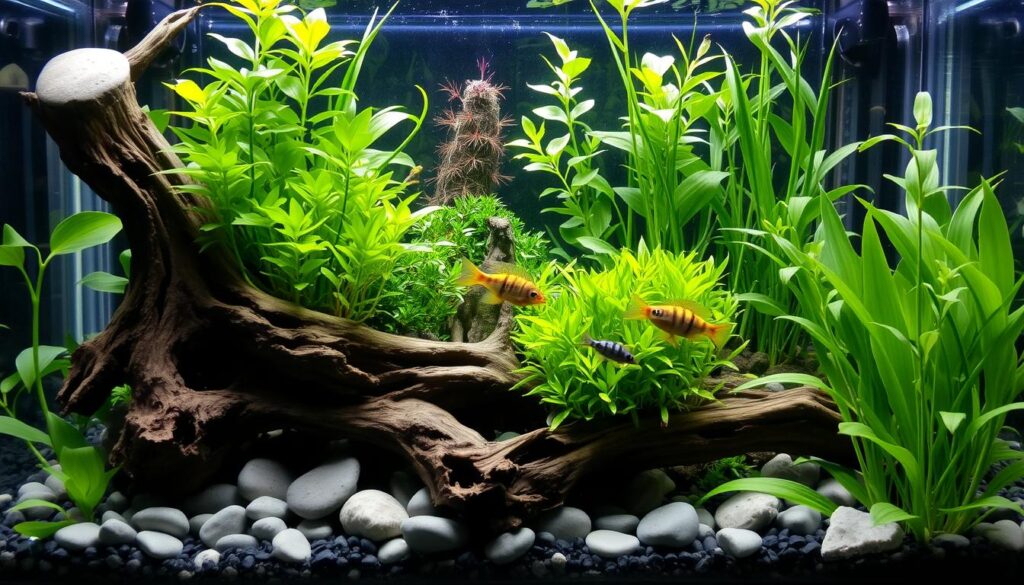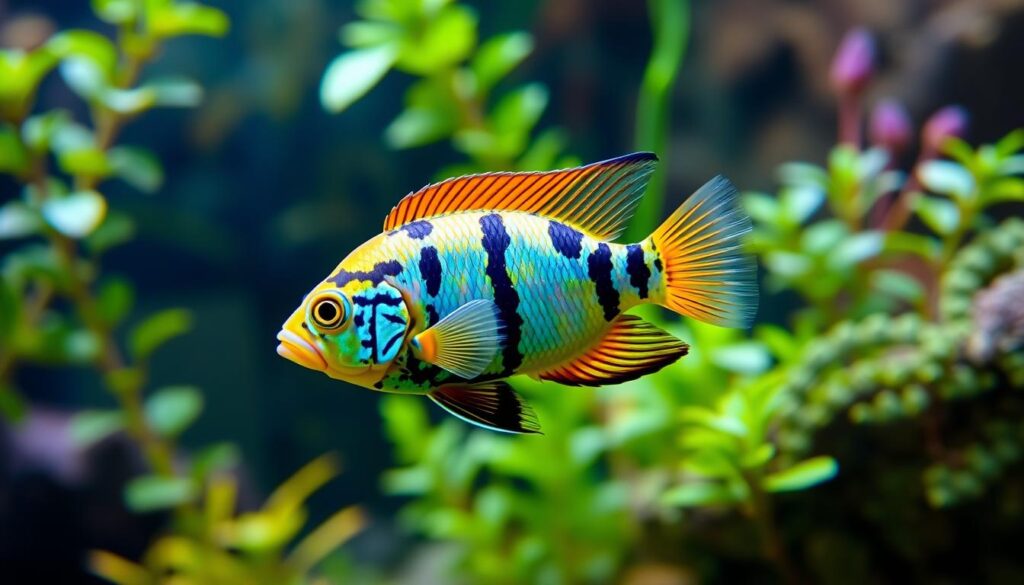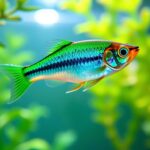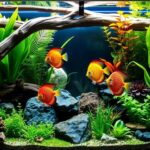Did you know the Cockatoo Dwarf Cichlid has been a favorite for over 60 years? It was first brought to the U.S. in the early 1950s. Since then, it has won the hearts of many with its bright colors and a dorsal fin that looks like a cockatoo’s crest.
The Apistogramma cacatuoides is incredibly adaptable. Found in Peru, Colombia, and Brazil, these fish can live in many water conditions. They come from areas where the water’s pH can go up to 8.0.
What makes the Cockatoo Dwarf Cichlid stand out is its stunning dorsal fin. In the wild, they are already beautiful. But in domestic varieties, they get even more colorful, showing off red and orange shades. It’s no surprise they’re a hit with fish keepers!
These fish like to stay near the bottom. They do well in long, shallow tanks that mimic their natural home. This makes them perfect for those who love nano fish and want a piece of South America in their aquarium.
Key Takeaways
- Cockatoo Dwarf Cichlids have been popular in the aquarium trade since the 1950s
- They originate from South America, specifically Brazil, Peru, and Colombia
- These fish adapt well to varying water conditions
- Domestic bred varieties often display more vibrant colors than wild types
- They prefer tanks with a larger footprint rather than tall aquariums
- Breeding pairs can produce clutches of 75-150 eggs on average
- Female Cockatoo Dwarf Cichlids exhibit strong parental care for their young
Introduction to the Cockatoo Dwarf Cichlid
I’m excited to share my knowledge about the Cockatoo Dwarf Cichlid. This freshwater aquarium fish has been a favorite for over 60 years. They are scientifically known as Apistogramma cacatuoides and were first described in 1951 by J.J. Hoedeman, a Dutch ichthyologist.
Origin and Natural Habitat
Cockatoo Dwarf Cichlids come from the Amazon River basin in South America. They are found in Brazil, Peru, and Colombia. They live in backwaters, tributaries, and creeks. These fish prefer smaller bodies of water with soft, acidic conditions.
Physical Characteristics and Behavior
These fish grow up to 3 to 3.5 inches long. Males are usually bigger than females. They are known for being curious and often interact with their owners. When they breed, males and females show clear differences in color, with females having bold black and yellow patterns.
Popularity in the Aquarium Hobby
The Cockatoo Dwarf Cichlid is popular for its adaptability and looks. While wild types are rare, tank-bred varieties like Double Red, Triple Red, and Orange are in high demand. Their ability to live in different water conditions has made them a favorite in the freshwater aquarium trade.
| Characteristic | Detail |
|---|---|
| Maximum Size | 3.5 inches (9 cm) |
| Lifespan | Up to 5 years |
| Ideal Temperature | 75 – 81°F (23 – 27°C) |
| pH Range | 6.0 – 8.0 |
| Diet | Omnivore |
Taxonomy and Scientific Classification
The Apistogramma cacatuoides is a standout in the dwarf cichlid world. Its scientific journey is quite interesting. Dutch ichthyologist J. J. Hoedeman first described it in 1951. Before that, it was just known as Apistogramma “U2” (unknown #2).
This fish belongs to the Apistogramma genus, a group of South American dwarf cichlids. This group has almost 100 species. It shows how diverse these small fish are.
- Kingdom: Animalia
- Phylum: Chordata
- Class: Actinopterygii (ray-finned fishes)
- Order: Perciformes
- Family: Cichlidae
- Genus: Apistogramma
- Species: A. cacatuoides
Out of 22,861 pictures in the Animalia kingdom, only 1,173 are of ray-finned fishes. The Cichlidae family, which includes our cockatoo dwarf cichlid, has 42 pictures. These pictures help researchers and fans learn about these fish.
The apistogramma cacatuoides is unique among South American dwarf cichlids. It can live in alkaline water, making it fit for many aquariums. Its looks and adaptability have made it popular in aquariums.
Cockatoo Dwarf Cichlid Varieties and Color Morphs
The cockatoo cichlid is a fascinating species with diverse color variations. These dimorphic cichlids show striking differences between wild and captive-bred types.
Wild Type Appearance
In their natural habitat, cockatoo cichlids have more subtle colors. They often have a mix of blues and greens. Males have brighter colors than females. Wild ones are 2-3.5 inches long, with males bigger than females.
Popular Bred Varieties
Aquarium fans have created stunning color morphs through selective breeding. Some popular types include:
- Super Red
- Double Red
- Triple Red
- Orange Flash
These bred types often have more vibrant colors than wild ones. This makes them very popular in the aquarium trade.
Distinguishing Males from Females
Cockatoo cichlids are sexually dimorphic. This means males and females look very different. Here’s a quick comparison:
| Characteristic | Males | Females |
|---|---|---|
| Size | Up to 3.5 inches | Up to 2 inches |
| Coloration | Vibrant, bold colors | Less colorful, muted tones |
| Fins | Elongated dorsal fin | Shorter fins |
| Head shape | Enlarged, disproportionate growth | Proportionate to body |
| Breeding colors | Intensified overall coloration | Bold black and yellow pattern |
Knowing these differences helps in picking and caring for these beautiful fish in your aquarium.
Setting Up the Ideal Aquarium for Cockatoo Dwarf Cichlids

Creating the perfect home for Cockatoo Dwarf Cichlids begins with a 20-gallon long aquarium. This size gives these fish enough space to live well. I use a thin layer of fine sand as the substrate, which matches their natural habitat.
To make a biotope aquarium, I add driftwood and caves. Ceramic pots or coconut shells are great for hiding spots. Plants like Anubias, Java fern, and Java moss add a natural look and provide cover. These elements help reduce aggression among the fish by breaking up sight lines.
Here’s a quick guide to setting up your Cockatoo Dwarf Cichlid tank:
- Tank size: 20 gallons or larger
- Substrate: Fine sand
- Decor: Driftwood, caves, and plants
- Water: Soft and slightly acidic
- Temperature: 80-82°F (27-28°C)
For breeding, a 10-gallon setup works well. I use a sponge filter for gentle water movement and add lots of Java moss. This setup creates a cozy place that encourages spawning.
| Tank Type | Size | Ideal Setup |
|---|---|---|
| Community | 20+ gallons | 1 male, 2-3 females, compatible tankmates |
| Breeding | 10 gallons | 1 pair, dense planting, slow water movement |
These adaptable fish can do well in various conditions. But, mimicking their natural environment shows off their best colors and behaviors.
Water Parameters and Maintenance
Keeping the right water conditions is key for the health of freshwater aquarium fish like the Cockatoo Dwarf Cichlid. These fish need specific environments to thrive. I’m excited to share what I’ve learned about their care.
Temperature Requirements
Cockatoo Dwarf Cichlids like warm waters. I keep my tank between 79°F and 84°F (26°C to 29°C). This temperature range is close to their natural habitat, keeping them active and healthy.
pH and Hardness Preferences
These cichlids prefer slightly acidic to neutral water. I aim for a pH between 6.0 and 7.0. For water hardness, they do well in soft to moderately hard water, around 2-15 dKH. It’s amazing how adaptable these fish can be!
Water Change Schedule
Regular water changes are crucial for happy, healthy fish. I perform 50% water changes every 1-2 weeks. This keeps the water clean and maintains stable conditions. Remember, sudden changes can stress your fish, so consistency is key.
| Parameter | Ideal Range | Maintenance Frequency |
|---|---|---|
| Temperature | 79-84°F (26-29°C) | Daily check |
| pH | 6.0-7.0 | Weekly test |
| Hardness | 2-15 dKH | Monthly test |
| Water Changes | 50% | Every 1-2 weeks |
By following these guidelines, I’ve created a thriving environment for my Cockatoo Dwarf Cichlids. It’s rewarding to see these south american cichlids flourish in my freshwater aquarium. With proper care, they can live up to 5 years, bringing joy and color to your aquatic world.
Feeding and Nutrition for Apistogramma cacatuoides

Feeding Cockatoo Dwarf Cichlids is an interesting task. These small fish eat a variety of foods, making them simple to feed in aquariums. Their diet is similar to what they eat in the wild, from the Río Ucayali in Peru.
These dwarf cichlids do well with a mix of foods. I give them high-quality flakes and small pellets as their main food. I also add frozen foods like bloodworms, brine shrimp, and daphnia. Sometimes, I treat them with live foods such as blackworms or small cherry shrimp, which they love.
One fun thing I’ve seen is their “eartheater” behavior. They dig through the sand to find small bits of food. This helps them stay active and happy in their tank.
| Food Type | Frequency | Benefits |
|---|---|---|
| Flakes/Micropellets | Daily | Balanced nutrition |
| Frozen Foods | 2-3 times a week | Protein boost |
| Live Foods | Once a week | Natural behavior stimulation |
When breeding, I feed the fry more often. They love to eat tiny brine shrimp and microworms. With the right food, these cute dwarf cichlids can live up to 5 years, making any fish lover happy.
Breeding Cockatoo Dwarf Cichlids
Breeding Cockatoo Dwarf Cichlids is rewarding for aquarium fans. These peaceful fish have interesting breeding habits. They are great to watch in a biotope aquarium.
Courtship Behavior
In a 45-gallon tank, I’ve seen unique courtship rituals. Males show off bright colors and dance to get the females’ attention. It’s important to have caves or clay pots for spawning, like their natural home.
Spawning Process
Females lay eggs every 3-4 weeks, picking a hidden spot. The male then fertilizes the eggs. These hatch in 3-4 days. Some keepers move the male away after fertilization to protect the babies.
Fry Care and Development
The fry start swimming freely about a week after hatching. Feeding them commercial first bites, newly hatched brine shrimp, and microworms works well. Adding java moss lets the fry graze naturally.
For breeding success, create a biotope aquarium with soft, acidic water and lots of hiding places. With the right care, you’ll soon have a thriving Cockatoo Dwarf Cichlid colony in your peaceful fish tank.
Compatible Tank Mates and Community Setup
Cockatoo Dwarf Cichlids are great for peaceful freshwater aquariums. They do well with other calm fish that live in different parts of the tank.
For a peaceful community, add small tetras, pencilfish, or hatchetfish. These fish swim in the middle to upper water column. They match well with the Cockatoo Dwarf Cichlids, which live on the bottom. A group of 6 or more Cardinal Tetras looks beautiful and helps reduce fights among the cichlids.
Here’s a list of tank mates that work well with Cockatoo Dwarf Cichlids:
- Neon Tetras
- Pygmy Corydoras
- Otocinclus Catfish
- Dwarf Gouramis
- Black Skirt Tetras
Apistogramma cacatuoides like temperatures of 72-84°F and a pH of 6.0-7.0. A 20 to 30-gallon tank is perfect for these fish and their friends.
Don’t put Cockatoo Dwarf Cichlids with aggressive or big fish. In my tanks, small, peaceful fish make the best neighbors for these charming cichlids.
Conclusion
I’ve learned to love the cockatoo dwarf cichlid (Apistogramma cacatuoides) as a great choice for aquariums. They stand out with their bright colors and lively nature. Males can grow up to 3 inches, while females reach 2 inches, ideal for smaller tanks.
These fish are very adaptable. They can live in different water conditions, from soft and acidic to harder water with a pH of 7-8. A 10-gallon tank is enough for a breeding pair, showing they fit well in compact spaces. Their breeding is interesting, with females laying 20-60 orange-red eggs that hatch in about 4 days.
As community fish, captive-raised Apistogramma cacatuoides get along well with other species. Wild-caught ones might prefer their own tank or small dither fish. With the right care, these cichlids can bring joy for many years. They’re a great pick for both new and seasoned fish keepers.
FAQ
What is the natural habitat of Cockatoo Dwarf Cichlids?
What are the ideal tank conditions for keeping Cockatoo Dwarf Cichlids?
What do Cockatoo Dwarf Cichlids eat?
How can you distinguish male and female Cockatoo Dwarf Cichlids?
What are the breeding requirements for Cockatoo Dwarf Cichlids?
What are some suitable tank mates for Cockatoo Dwarf Cichlids?
Source Links
- The Cockatoo Dwarf Cichlid | Tropical Fish Hobbyist Magazine
- Cockatoo Dwarf Cichlid-Apistogramma cacatuoides
- Cockatoo Dwarf Cichlid (Apistogramma cacatuoides)
- Cockatoo Dwarf Cichlid – Apistogramma cacatuoides Fish Profile & Care Guide
- Apistogramma cacatuoides
- ADW: Apistogramma: CLASSIFICATION
- Cockatoo Dwarf Cichlid | Apistogramma cacatuoides
- Cockatoo Cichlid Care Guide & Species Profile
- Care Guide for Apistogramma Dwarf Cichlids — Housing, Breeding, & More
- What to keep with Cockatoo Cichlids?
- Apistogramma Dwarf Cichlids | Tropical Fish Hobbyist Magazine
- pH range for South American Cichlids
- Blue Cheek Dwarf Cichlid – Apistogramma eunotus Fish Profile & Care Guide
- Aquarium Central -American Cichlid Apisto – Apistogramma Cacatuoides Mega Orange 4cm – Aquarium Central
- Breeding Apistogramma Cacatuoides (Dwarf Cichlid)
- Dwarf Cichlid Breeding
- How many apistos in a 125? What tankmates?
- Harmonious Haven: Apistogramma Tank Mates Unveiled🐠| Fish Lab
- Apistogramma Tank Mates For Community Aquariums
- Apistogramma cacatuoides
- Apistogramma cacatuoides (Cockatoo Cichlid) — Seriously Fish


